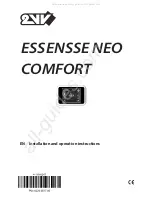
300M
shall be
the entrance doorway
, or on
may
s
If you use an electro-mechanical lock, connect
for example 1N4007, not supplied directly
the
’s
Use copper wires for connections with regard to the acceptable cross-sections and lengths shown in the below table:
To ensure proper operation, total c
ance
s
r
and c
u
must
perform the control unit’s setup. R
on the PCB
The
determines
logic and should comply with the lock type used
,
across its terminals
,
across its terminals
The
determines
-
To ensure door unlocking from the inside, the EXIT
button
installed inside
near
the door. Any button with NO contacts
be used as well. See the example of connection diagram on Fig.
.
a damper diode (
)
to
lock
terminals (see Figure ).
*
apacit
of cable connecting the eader
ontrol nit
not exceed 2500 pF.
,
emove the lid and set jumpers
according to
the table:
jumper
lock control
:
Set the jumper to
position in case of an electromagnetic lock.
The lock will release when voltage
is off.
Set the jumper to
position in case of an electromechanical lock.
The lock will release when voltage
is on.
jumper
unlocked state duration 1 or 7 seconds.
1 2
WARNING.
unit
IMPORTANT.
DO NOT use electromagnetic locks with impedance less than 20 Ohms and not provided with a
2
,
Do not mount the power supply
near heating equipment!
built-in
degaussing module.
LOCK
ML
EL
TIME
Before turning the power on
-
-
unit
19w/14.4v/EU (12V/1.5A) may
heated
,
To provide power for
, the power supply
BPD18/12-1-1 or
be used. It
should be installed in a
place with proper ventilation and fixed on a wall or a DIN-rail.
VIZIT-KTM600R
Circuit
Wire
Maximum length,
m
0 3
.
Diameter,
mm
0 07
.
Cross-section,
mm
2
0 2
.
0 5
.
0 5
.
0 8
.
Control Unit
«
Reader
Control Unit
«
Button for exit
10
10
30
50*
5
25
25
50*
50
50
50*
50
BPD
ontrol Unit
«
C
«
Electromagnetic lock
BPD
ontrol Unit
«
C
«
Electromechanical lock
Lock Type
Jumper
Electromagnetic
Figure
(
)
VIZIT-ML400
1
Electromechanical
Figure
(
)
EL-301B
2
LOCK
ML
EL
TIME
7s
1s
ML
EL
PRG
1S
7S
www.vizit.eu
VIZIT-КТМ600R
3/6
OPERATING INSTRUCTION
























